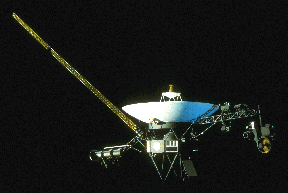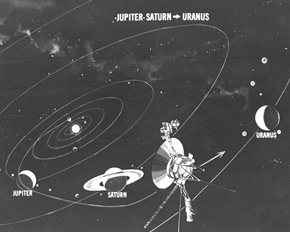Voyager mission artwork depicting the Voyager spacecraft's trajectory...made in 1977.
Click on image for full size
Courtesy of NASA
Voyager to Take the Lead!
News story originally written on February 16, 1998
At approximately 5:10 p.m. EST on February 17, 1998, the Voyager 1 spacecraft will become the spacecraft that has traveled farthest away from the planet Earth. For 25 years,
Pioneer 10 has been in the lead in this race. It's not that the Voyager will overtake the Pioneer in a neck-and-neck race. The Pioneer spacecraft is headed in the opposite direction from the Sun.
When Voyager 1 becomes the most distant man-made object in space, it will be 6.5 billion kilometers from the Earth. At this distance the Sun shines 1/5,000th as bright as it does here on Earth.
Voyager 1 is still exploring the outer solar system. The spacecraft passed Pluto and is still traveling outward. Scientists are hoping that the spacecraft will reach the heliopause, where the Sun's influence stops. This would truly be where no spacecraft has gone before!
The Voyager spacecraft is expected to near the heliopause by 2002.
You might also be interested in:

The rare geometric arrangement of planets Jupiter, Saturn, Uranus, and Neptune in the 1980's made it possible for the Voyager spacecrafts to visit them over a 12 year span instead of the normal 30. They
...more
It was another exciting and frustrating year for the space science program. It seemed that every step forward led to one backwards. Either way, NASA led the way to a great century of discovery. Unfortunately,
...more
The Space Shuttle Discovery lifted off from Kennedy Space Center at 2:19 p.m. EST, October 29th. The sky was clear and the weather was great as Discovery took 8 1/2 minutes to reach orbit for the Unitied
...more
A moon was discovered orbiting the asteroid, Eugenia. This is only the second time in history that a satellite has been seen circling an asteroid. A special mirror allowed scientists to find the moon
...more
Will Russia ever put the service module for the International Space Station in space? NASA officials are demanding an answer from the Russian government. The necessary service module is currently waiting
...more
During a period of about two days in early May, 1998, the ACE spacecraft was immersed in plasma associated with a coronal mass ejection (CME). The SWICS instrument on ACE, which determines unambiguously
...more
J.S. Maini of the Canadian Forest Service has referred to forests as the "heart and lungs of the world." Forests reduce soil erosion, maintain water quality, contribute to atmospheric humidity and cloud
...more















